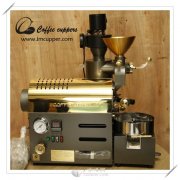Grading standard of raw coffee beans
There are two ways to classify brown raw beans, one is to filter the number, and the other is to divide it by elevation.
It is divided by the number of the filter screen, and the size is in the unit of the screen (size).
Round beans are generally smaller than flat beans, between 8-13 and 12-29.
8, 9, 10. 12, 13. 18. 29 = > small, medium, ordinary. Quasi-big. Big, extra large. The bigger the size, the bigger the beans. SC-19, for example, is the No. 19 bean.
Grade by level
According to the elevation of the cultivated land, it can be divided into seven grades. Generally speaking, the quality of highland beans is better than that of lowland beans, and the price is higher because of the increase in freight.
Sequence number equal order abbreviated elevation
1 selected quality beans S.H.B 4500 ~
2 good coffee beans H.B 4000mm 4500
3 medium coffee beans S.H 3500 million 4000
4 super high-grade washed coffee beans E.P.W 30003500
5 first-class washed coffee beans P.W 250000 3000
6 special water washed coffee beans E.G.W 2000 2500
7 High quality washed coffee beans G.W ~ 2000
Grading purpose: to make the size of raw beans uniform, which is conducive to the baking operation, and improve the value of raw beans.
Screen diameter
The size of the international practice is 9: 22, and the number used represents the diameter of the screen, with this number as the numerator and 64 as the denominator, in inches. For example, 14 refers to raw coffee beans that can be sifted through a 14-inch screen with a diameter of 64 inches, and 19 + refers to raw coffee beans that can be sifted with a diameter of more than 64 inches with a 19-inch screen.
Grading standard and code name
The governments of each coffee-exporting country set their own grading standards and code names.
Common grading standards
Block transactions:
The proportion of bad beans
Bean size
Soybean grain hardness
Single coffee (specialty coffee):
Name of the farm where it is produced
Organic cultivation (organic)
Fair trade (fair trade)
African countries-Kenya kenya
PB: peaberry
AA Plus-plus
AA plus
AA: Screen 17 and 18
AB: screen 15 and 16
C
E
African countries-Ethiopia
300 grams of raw beans as the basis for calculation
1: 0-3 defects
2: 4-12
3: 13-25
4: 20-45
5: 46-100
6: 101-153
7: 154-340
8: over 340 = substandard
South America-Colombia
Maragogype: special trees Marago Rippi, elephant bean
Supremo: screen > 17
Excelso: screen 15-16.5
UGQ: Usual Good Quality: Screen 12-14
South America-Brazil
Type Defects (COB) (New York) (Le Havre)
2 4 6 8
2/3 8 9 12.5
3 12 13 17
3/4 19 21 23.5
4 26 30 30
4/5 36 45 58.5
5 46 60 87
5/6 64 123
6 86 158
Central America-Guatemala
Good Washed: altitude 700m (GW)
Extra Good Washed: 700Universe 850m (EGW)
Prime Washed: 850Universe 1000m (PW)
Extra Prime Washed: 1000Universe 1200m (EPW)
Semi Hard Bean: 1200Compact 1350m (SH)
Hard Bean: 1350max 1500m (HB)
Fancy Hard Bean: 1500Comp1600m (FHB)
Strict Hard Bean: 1600thumb 1700m (SHB)
Central America-El Salvador
Washed washing
Central Standard: 5000000m (CS)
High Grow: 9001,200m (HG)
Strictly High Grown: > 1200 m (SHG)
Natural sun exposure
Coriente
Superior
Caracoil
Hawaii, Kona.
Kona Extra Fancy: screen 19 maximum 10 defects
Kona Fancy: Screen 18 max. 16 defs.
Kona Prime: no size requirement max. 25 defs.
Kona Caracoli No.1: Screen 10 max. 20 defs.
Jamaica jamaica
Blue Mountain
High Mountain Supreme
Prime Washed Jamaica aica
Grade Grade
Grade I: screen 18
Grade II: screen 17
Grade III: screen 16
Peaberry
Indonesia
300g raw beans are calculated based on Grade based on 300g.
1: 11 defects
2: 12-25
3: 26-44
4a: 45-60
4B: 61-80
5: 81-150
6: 151-225
Important Notice :
前街咖啡 FrontStreet Coffee has moved to new addredd:
FrontStreet Coffee Address: 315,Donghua East Road,GuangZhou
Tel:020 38364473
- Prev

Coffee Roasting Hot Air Roaster
Coffee roasting refers to the heating of raw beans to convert starch in raw beans into sugar and acidic substances at high temperature. Cellulose and other substances will be carbonized to varying degrees. Moisture and carbon dioxide will volatilize. Protein will be converted into enzymes and fats. The remaining substances will combine together to form an oil film layer on the surface of coffee beans. In the process, coffee acids will be generated.
- Next

Coffee roasting repeats itself between operation, observation, discarding and recording.
When the coffee was roasted in the morning, there was a sudden power outage, and a furnace in Colombia was scrapped. When there was a sudden power outage, turn off the main power supply and shake the coffee out of the oven with a handle, so the handle of the roaster should be tightly tied to the roaster. Otherwise, there will be a big fire in the furnace.
Related
- What is the meaning of lactic acid fermentation with coffee bean treatment?
- How to judge the state of foam by sound?
- How does the latte pull out the unicorn pattern? Come to get for a little trick to improve the flower pull!
- Will flower pulling affect the taste of the latte?
- Do you know the history of coffee?
- The difference between honey treatment and sun washing what is raisin honey treatment?
- What kind of milk can a novice use to make coffee foam to keep the foam longer? The correct method and skills of milking tutorial sharing
- Why do washed coffee beans taste sour? Flavor characteristics of washed Coffee
- Introduction to the skill of how to practice the size and height of water injection around the circle of hand-brewed coffee
- How do beginners practice coffee flower drawing from scratch?

